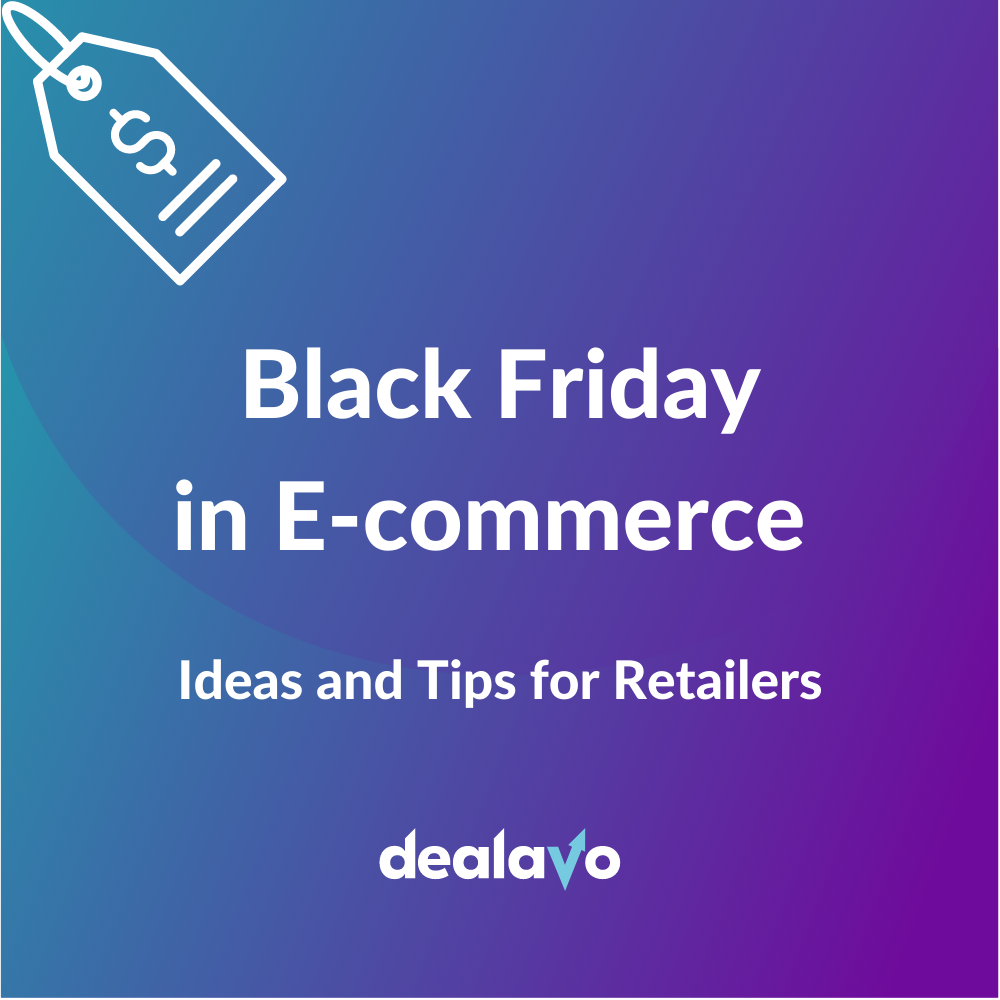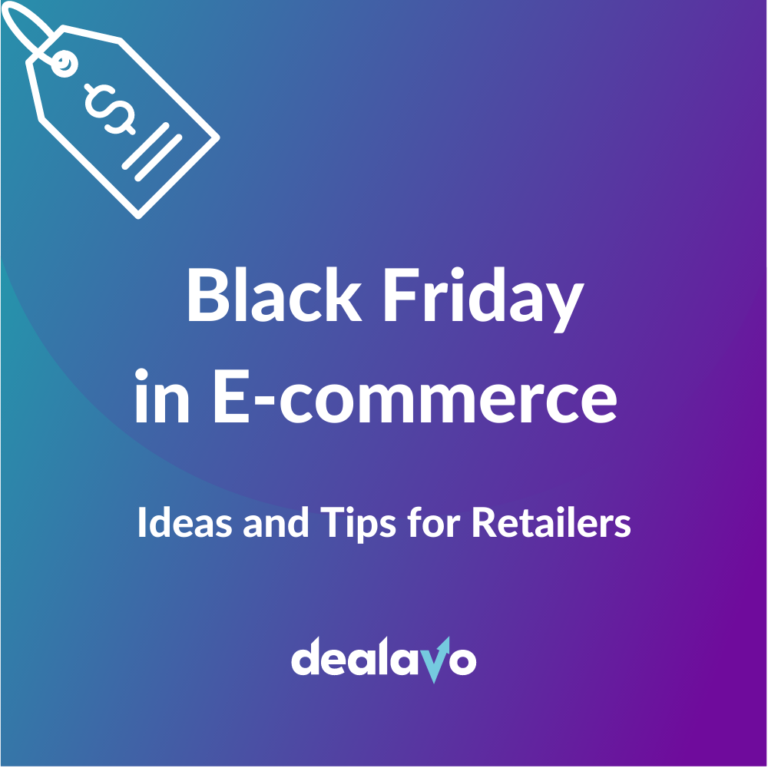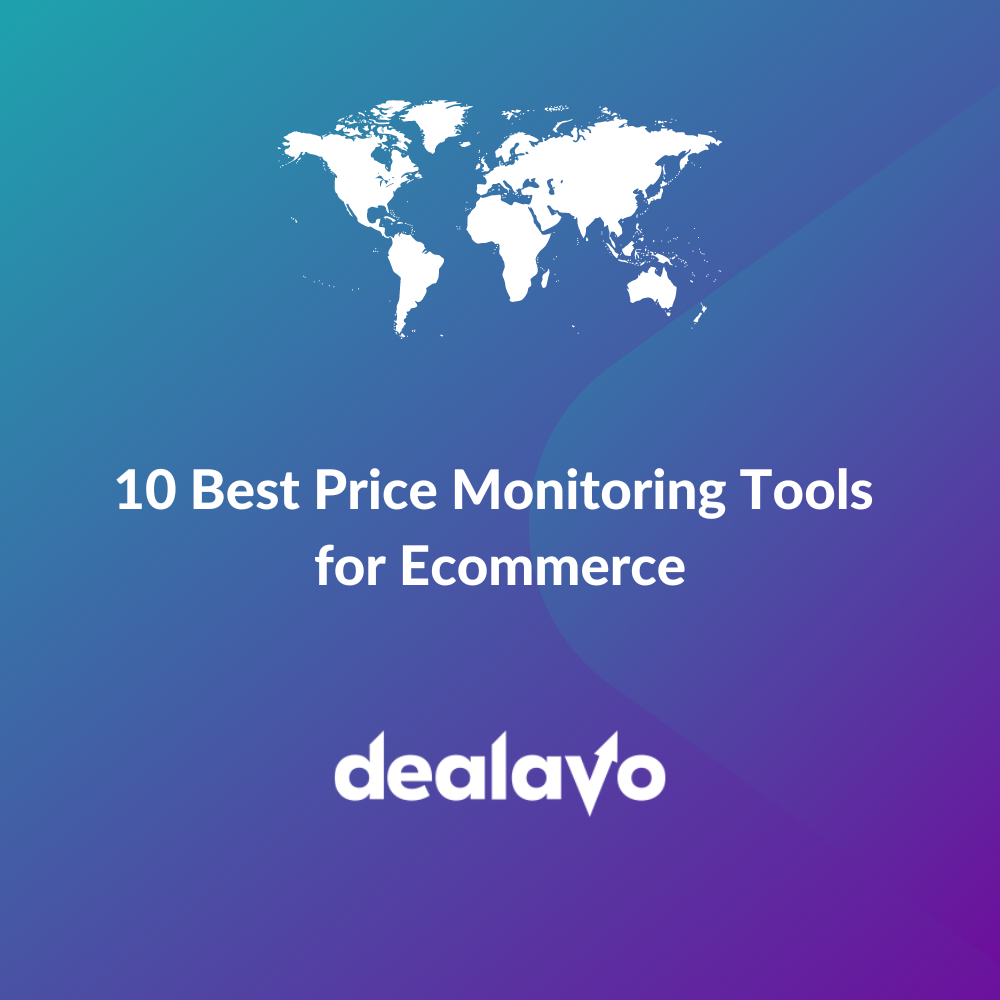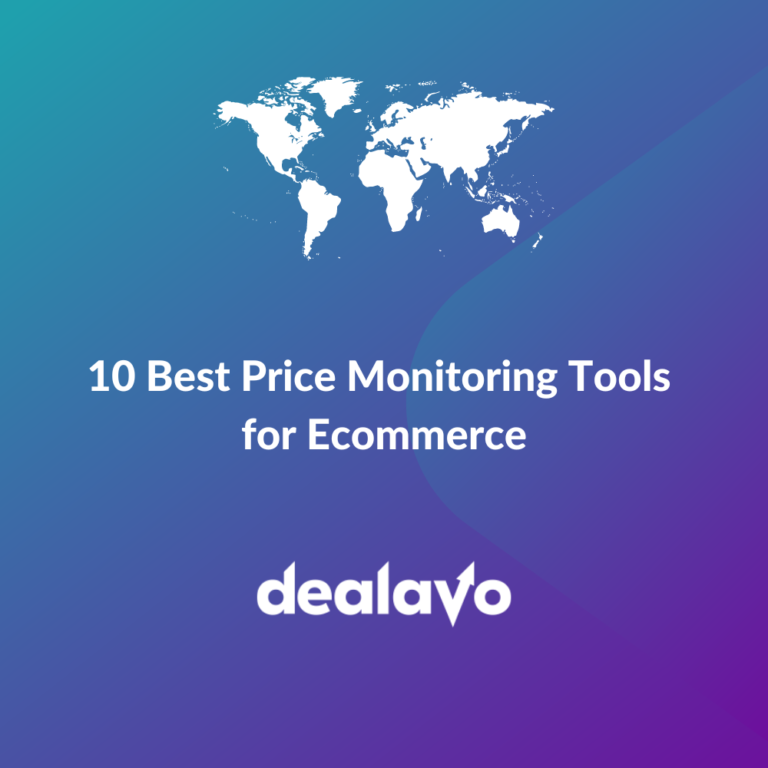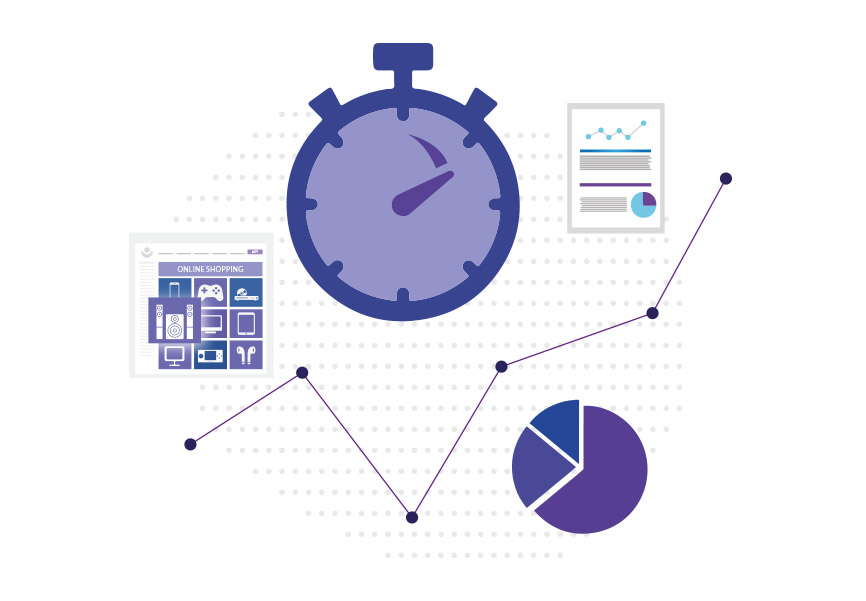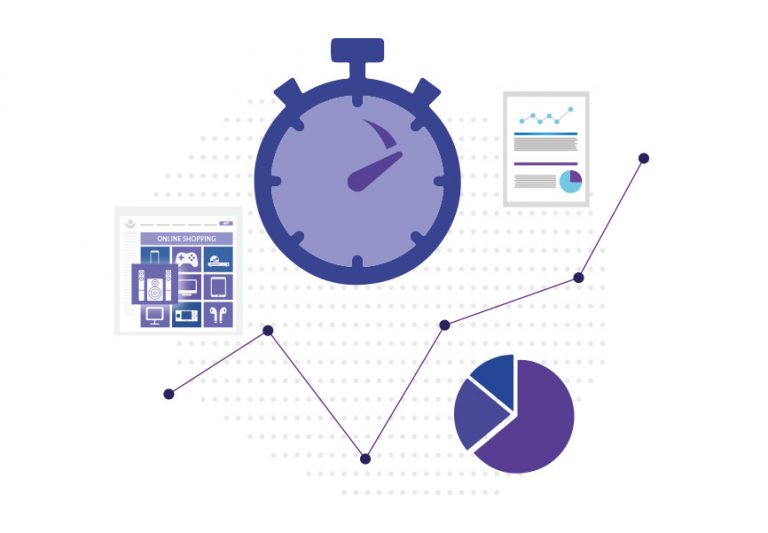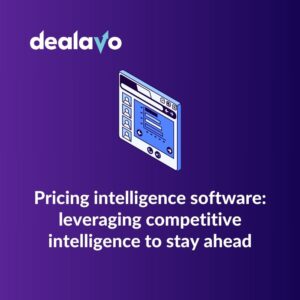
Pricing intelligence software: leveraging competitive intelligence to stay ahead
- 04 February 2025
With such a competitive market environment, making spontaneous decisions on pricing is no longer an option for any business, big or small. When just a minor change in price can lead either to a major drop in sales, or a huge, positive spike, a robust pricing strategy is a must.
Success is data driven, and largely depends on the company’s ability to prepare and adapt – as quickly as possible. Fortunately, with Pricing Intelligence software, the tedious and complex process of gathering the necessary information on the market and competitors can be greatly facilitated.
In this entry, I take a deep dive into the topic of Pricing Intelligence/Business Intelligence software solutions, and I invite you to join me on this journey.
Business Intelligence, Pricing Intelligence and Competitive Intelligence… what are they?
By now, you have most probably noticed I am using the two terms – Pricing Intelligence and Business Intelligence – interchangeably. While not the same, one could argue that the former is part of the latter.
Pricing Intelligence
Following the definition provided at vendavo.com:
“Pricing intelligence is defined as the process of gathering, analyzing, and leveraging data on pricing strategies across the market. It involves understanding competitive pricing, market trends, and customer behavior to optimize pricing strategies for informed business decisions.”
Business Intelligence
As for Business Intelligence, Craig Stedman from TechTarget provides a clear explanation:
“Business intelligence, or BI, is a technology-driven data analysis process that helps an organization’s executives, managers and workers make informed business decisions. As part of the BI process, relevant data is collected and prepared for analysis. Queries are run against the data, and the analytics results are used to support operational decision-making and strategic planning. […] The ultimate goal of BI initiatives is to drive better business decisions that enable organizations to increase revenue, improve operational efficiency and gain competitive advantages over business rivals […]“
Competitive Intelligence
As for Competitive Intelligence, we have an entry by Andrew Bloomenthal at Investopedia:
Competitive Intelligence, sometimes referred to as Corporate Intelligence, refers to the ability to gather, analyze, and use information collected on competitors, customers, and other market factors that contribute to a business’s competitive advantage. Competitive intelligence is important because it helps businesses understand their competitive environment and the opportunities and challenges it presents.
Competitive Intelligence benefits each person differently depending on their department and role in a company.
As you can see, all three terms basically refer to the collection of data on the business environment, including price trends, and other companies with the goal of gaining an edge over the competition, growth, and providing the best offers on the market.
The methods of Competitive Intelligence
Below you’ll find a few common and trusted methods used in Competitive Intelligence gathering.
From SWOT to TOWS
You might have already heard about the popular SWOT acronym – Strengths, Weaknesses, Opportunities, Threats. Focusing on these four key notions means:
- Looking into what your company does well when compared to its competitors (strengths)
- Investigating those areas that could be improved, especially if the competition has ways of performing similar tasks more efficiently (weaknesses)
- Identifying the chances for positive changes in your company (opportunities)
- Being aware of those aspects that may have a negative impact on your business (threats)
SWOT is often the natural first step in Competitive Intelligence. With the data acquired during this stage, it’s a good idea to continue with the TOWS approach. While at first glance it may seem to be simply the reversal of SWOT, TOWS is more than that. It takes the knowledge acquired in the previous analyses and tries to find a link between these elements to solve issues or seek out improvements:
- Strengths to Opportunities – How to make use of your strengths to maximize your profits/gains in relation to the market you operate in?
- Strengths to Threats – How can you make use of your strong sides to permanently mitigate the threats in your market?
- Weaknesses to Opportunities- Are there any opportunities on the market that you could seize in order to overcome the weak points of your business?
- Weaknesses to Threats – How to mitigate the threats on the market and reduce the impact of your weaknesses?
Porter’s Four Corners
Michael Porter designed a technique with the intention of helping company strategists in evaluating the intentions and uncovering the goals of competitors, along with their strong sides which they successfully apply to achieve these targets. By analyzing the current strategy of the competitor, his goals and basic capabilities, the Four Corners technique helps in finding answers to the following questions:
- What does the competitor do, and what is he capable of? (action – strategy)
- What are his strong and weak points? (action – capabilities)
- What is he motivated by? (motivation – drivers)
- What assumptions does the managing body of the competitor make? (motivation – management assumptions)
Porter’s Five Forces approach
Here is another of Professor Porter’s ideas for Competitive Intelligence gathering. The approach was first presented in 1979 and still remains one of the most popular business strategy tools.
You can read the full article on the subject on Researchgate. In a nutshell, according to Porter, there are five forces that represent the key sources of competitive pressure in an industry, with critical questions that need answering.
- The threat of new entrants: How easy is it for new competitors to enter the market?
- The bargaining power of suppliers: How big is the strength of suppliers when it comes to their influence on prices and conditions?
- The bargaining power of buyers: How strong is the influence of customers on prices and conditions?
- Competitive rivalry: How strong is the competition between existing companies, and who are the current competitors?
- Threat of substitute products or services: How likely is it that customers will move on to alternative products or services?
Quantive describes specific cases for the application of Porter’s Five Forces:
- The analysis of the competitive environment of the current market: you can analyze the intensity of the current competition and the dynamics among providers and buyers.
- When a company is considering entering a new industry or a new market: in this case, the framework helps in the understanding of competitive dynamics, the barriers for entry and profitability.
- Reacting to competitor changes: the framework facilitates the understanding of the results of such changes, and helps in making strategic decisions to maintain the competitive edge.
- Developing a business strategy: the framework provides a structured approach to the evaluation of competition, providing a solid and well-adapted strategy.
- Evaluating the potential company fusions and takeovers: in this case, Porter’s Five Forces help in the evaluation of attractiveness and risks connected to the target industry.
Other methods of Competitive Intelligence analysis
There are many different frameworks used in this type of investigation and there is no room in this article to describe them all in detail, so I’ll just mention them briefly. You can read Safe Graph’s entry for more information on:
- Value chain analysis
- BCG growth-share matrix
- Scenario analysis
- PEST analysis
Pricing Intelligence software in action
Manual data gathering as part of Price Intelligence operations is usually a time consuming and tedious task. Fortunately, there are several development studios supported by e-commerce specialists that created appropriate software to streamline and speed up PI processes. Most solutions of this kind are subscription-based and accessible through an online browser. You can read my previous article with a more detailed description of price tracking software commonly used in Price Intelligence analyses at the end of 2024, here are some popular and trusted brands:
- Prisync
- Price2Spy
- Competera Pricing Platform
- Wiser
- Intelligence Node
- Skuudle
- …and, of course, Dealavo
I’ll use the example of our tool to give you an idea of how Pricing Intelligence software will support your business.
Features and advantages of modern pricing intelligence software – Dealavo
Dealavo is an all-in-one, browser-based, easy-to-use solution that combines the features of pricing intelligence, business intelligence and competitive intelligence software.
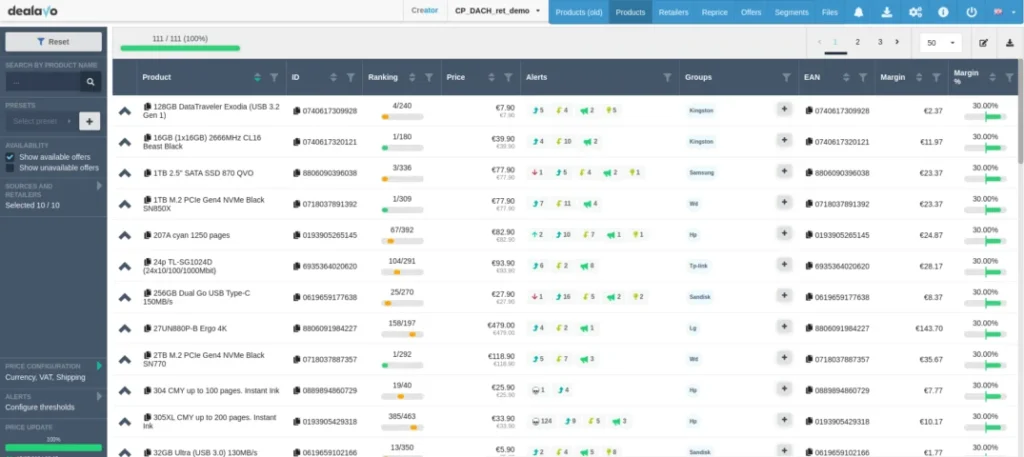
Its features enable companies the development of effective business and pricing strategies to remain competitive on the market and outmatch the competition. With Dealavo, business owners are sure their offer is always up-to-date with the current market situation, and can react accordingly to changes. The software provides the following key functionalities:
Price monitoring
The core functionality of any Pricing Intelligence software – price monitoring allows companies to keep track of product prices across markets of interest. With Dealavo, you can monitor prices of products in competitors’ online shops, at price comparison sites (e.g. CENEO), and marketplaces (e.g., Allegro, Amazon). The frequency of the updates is set to once per week by default, but it can be customized. With price monitoring you are able to quickly react to your competitors’ moves in terms of pricing, you can predict future prices and plan your strategy accordingly. Dealavo can present this information in charts, allowing you to track how product prices changed across months and years.
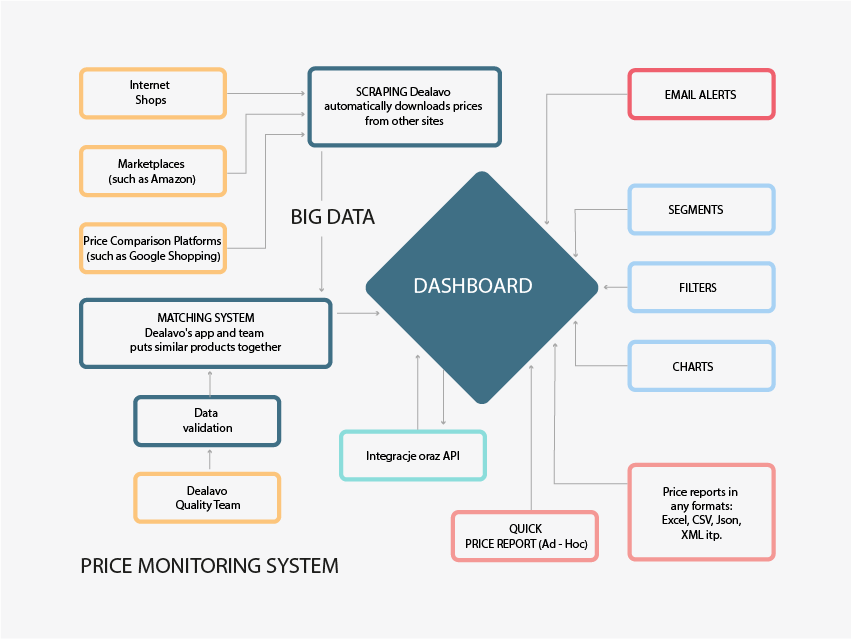
Advanced filters for a custom experience and precise data
There are many filters in the dashboard so you can instruct the software to present the information key to your business. The two most popular options among users are our “Easy gain” and “Clever move” settings.
The first one shows products in your portfolio for which you can increase the price of a product and still remain the most attractive offer on the market. For instance, if you are selling a specific product for $100, and the second-best offer on the market is $120, the algorithm will present this situation and suggest setting the price to $119. This way, you increase your margin and your offer remains the best.
The second option presents products in your portfolio that would jump to the top position in product listings after only a minor price decrease. Let’s say you are selling a specific model of a keyboard for $100, but there are 8 other competitors who sell the same product for $97-$99, the algorithm will suggest changing the price to $96. Your offer will become the best on the market, increasing your sales considerably.
There are also other interesting filters to choose from.
Dynamic pricing
While price monitoring provides companies with critical data regarding the market situation, dynamic pricing (or repricing) is a functionality that allows for better preparation and quick reaction to changes. With Dealavo, companies can set a number of parameters for their prices to automatically adapt to new situations without the need for manual control. This is particularly useful in cases where the number of products on offer in a shop is high enough to make manual price adjustments difficult if not impossible.
Our software can, for example, set the price of a product to be 5% lower than the current best competitor offer available on the market. At the same time, it is possible to set a minimum threshold for the algorithm, so that the price never falls below a specific level. There are hundreds of possible combinations, making sure your settings are adapted specifically to your needs.
Private Label management with the Private Label Panel
For those companies that sell private label products, Dealavo has a dedicated functionality. If you’re not sure what private labels are, here’s a quote from our subsite:
“Private labels – these are products whose manufacture was commissioned by a specific shop. They can be produced by various manufacturers, but are distributed and controlled entirely by the shops that ordered them.”
The Private Label Panel is a great time saver. It automatically searches the market for products that are similar to your private labels, and creates a list for you. With such information, you can better position your items and adapt your pricing to the changing market situation. You may also discover new products worth developing based on the items your competition has on offer, but your shop does not. It’s a simple, but powerful tool that helps companies win the market with their private label products.
Detailed reports
You’ll notice that some of the information presented in the Dealavo software can be downloaded in the form of clear reports. There are also two special features based on this functionality: Distribution Reports and Competitor’s Assortment Reports.
Distribution Reports
With Dealavo distribution reports you can see what the market coverage with your or competing products is, check the efficiency of the current distribution strategy and optimize it based on the collected data. This functionality helps decision makers analyze distribution, compare positioning against competitors and maintain competitiveness.
Competitor’s Assortment Report
With this functionality, the user receives a list of products offered by the competition with their availability and prices. The products that are missing in your offer when compared to the competition become evident. It will also be easier to identify the analogues to your products offered by other shops. For some products, it will be possible to check their availability in competitor stores.
Offline price monitoring
If the competitor store offers information on the availability of its products in selected offline shops, then Dealavo can monitor offline prices too. See more.
Easy integrations
Every reliable Pricing Intelligence suite should allow for a variety of integrations and Dealavo is no different. The software can be integrated with most popular e-commerce platforms and ERP systems either directly or through API. Read more about Dealavo integrations here.
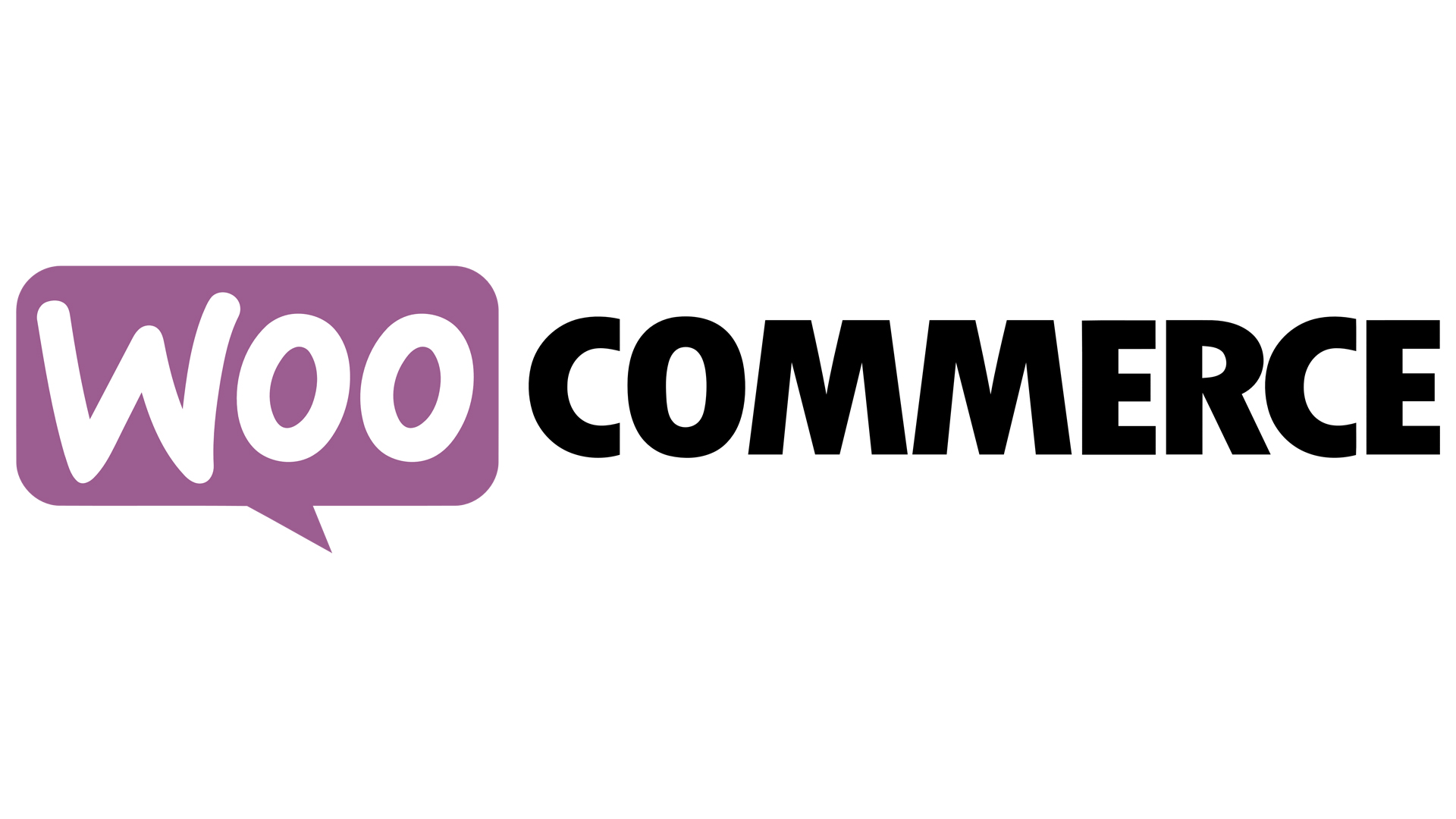
The benefits of Competitive Intelligence software for e-commerce
With so many reasons for e-commerce businesses to make use of Competitive Intelligence software, it’s only fitting to have a separate section to outline at least some of the advantages.
Discover and keep track of existing, new, and upcoming market trends
There are many different factors that shape market trends, including consumer behavior, economic situation, technological advancements, social influences, and at least a few others. Thanks to good Competitor Intelligence software, businesses are able to effectively observe, anticipate and take advantage of market trends to increase their profits.
Improve and develop new products while setting optimized prices
Knowing exactly what your competition is offering and at what price is one of the keys to an effective pricing strategy. With the right software, companies can compare their product portfolio, product features and prices with competitors to set better prices and/or introduce changes to become more competitive and improve sales.
Acquiring data to gain the competitive edge
With Competitive Intelligence analyses, companies gain insights into the strong and weak sides of their competitors, including the ways they advertise their products, their branding, tactics, the way they communicate with the same customers as your business is trying to attract, and the factors that make their offers stand out. Armed with this knowledge, companies can capitalize on the weak points of their rivals, or get inspired by what others do that works well for their businesses.
Risk reduction
Most markets at some point pose certain risks – supply shortages, cybersecurity threats, etc. Competitive Intelligence solutions help anticipate these threats and find better ways of mitigating them to avoid financial losses or a negative impact on brand reputation.
Understanding your customer base
To make better business decisions, it’s very important to be aware of what customers think not only about your business, but also about your competition, and Competitive Intelligence applications will help you acquire this critical data.
Identifying KPIs and establishing goals
With reliable information provided by Competitive Intelligence software it is easier to establish realistic goals and KPIs.
Monitoring competitor leadership
Now this is an interesting point. Competitive Intelligence gathering should also include information on the leadership of rivaling companies. Why? A change at C-level could mean a shift in a company’s business strategy… which may require your own business to adapt to your competitions’ new approach.
Improved product offer
Competitive Intelligence programs will help you see what your competitors are selling, which might be missing in your shop’s offer… and the other way round. Capitalize on the gaps in other companies’ product lists.
Optimized pricing strategies
By analyzing competitor prices, e-commerce businesses may develop an optimal pricing strategy. For example, if a competitor offers extras added to a popular product, or free shipping, a company can come up with a similar or better incentive and gain an edge.
Discovering new ways to advertise
By analyzing what methods of advertising work for your competitors, you might open up a new channel for yourself. Some examples may include – sponsored articles on specific websites, or partnerships with influencers (YouTubers, Twitch streamers) for product reviews or recommendations.
Conclusion
Pricing intelligence software – alongside business intelligence and competitive intelligence solutions – is a very important addition to any business wanting to stay competitive in the very dynamic environment of e-commerce. In this area, Dealavo provides an all-in-one, feature-rich suite for companies of all sizes to help them stay on top of their competition. Contact us to receive your free demo and discover the software’s full potential yourself.
Additional sources:
https://getlucidity.com/strategy-resources/an-introduction-to-tows-analysis/
https://www.herts.ac.uk/__data/assets/pdf_file/0007/290482/An-introduction-to-the-TOWS-analysis.pdf
